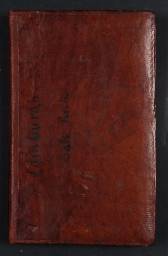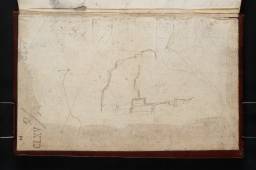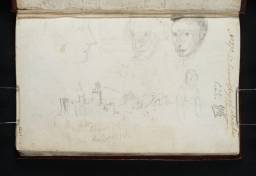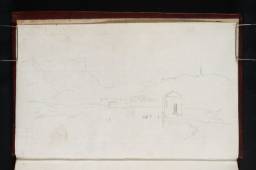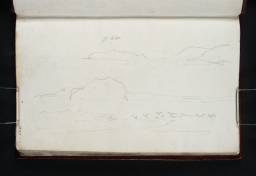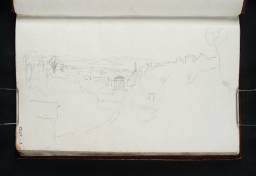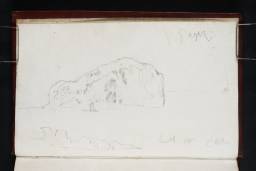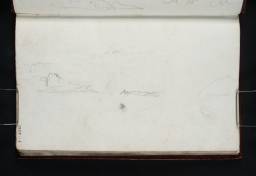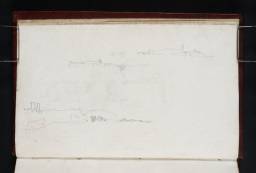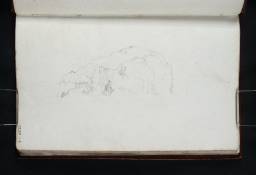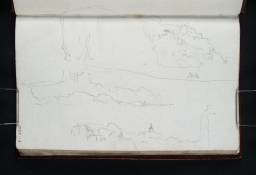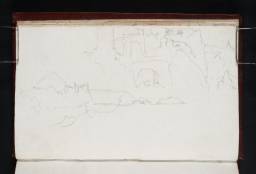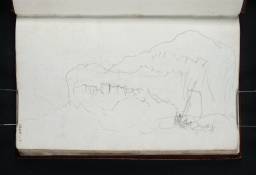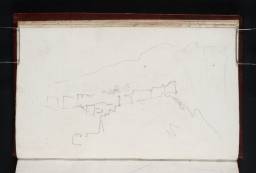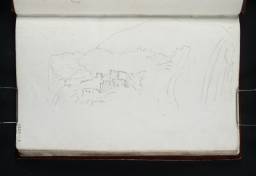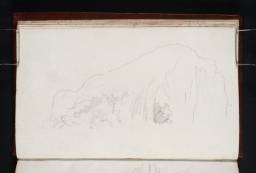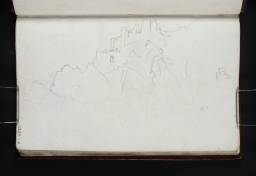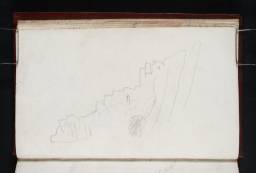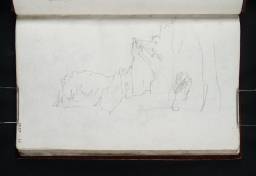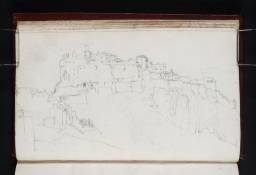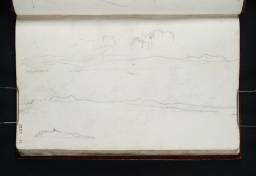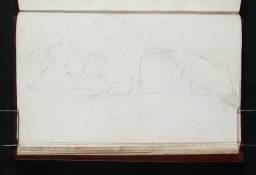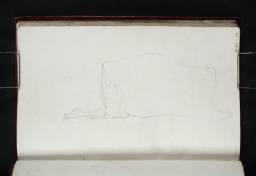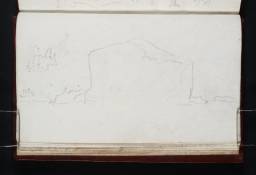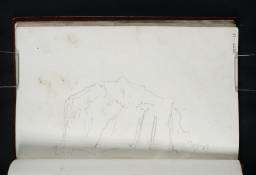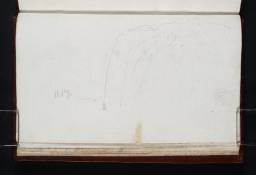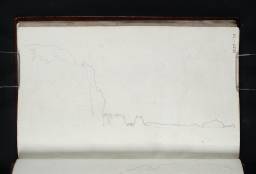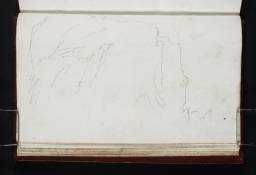Turner Bequest CLXV
Pocket book, with red leather covers
Leaves of corrected white (‘blue’) laid writing paper, made on a single-faced mould with chain lines approximately 25mm (1 inch) apart, and approximately 8 laid lines per centimetre (20 per inch).
Approximate page size 99 x 159 mm
Watermarked with an image of Britannia on folios 4, 5, 9, 10, 13–15, 18 – 20, 28, 29, 32, 33, 35, 38, 39, 42, 43, 46, 47, 56, 58, 59, 62, 63, 66 and ‘J DICKINSON & Co | 1814’ on folios 6–8, 11, 12, 14, 16–18, 21–24, 26, 27, 30, 31, 34, 36, 37, 40, 41, 44, 45, 48–55, 57, 60, 61, 64, 65
Made by John Dickinson at Apsley, or Nash Mill, Hertfordshire.
Leaves of corrected white (‘blue’) laid writing paper, made on a single-faced mould with chain lines approximately 25mm (1 inch) apart, and approximately 8 laid lines per centimetre (20 per inch).
Approximate page size 99 x 159 mm
Watermarked with an image of Britannia on folios 4, 5, 9, 10, 13–15, 18 – 20, 28, 29, 32, 33, 35, 38, 39, 42, 43, 46, 47, 56, 58, 59, 62, 63, 66 and ‘J DICKINSON & Co | 1814’ on folios 6–8, 11, 12, 14, 16–18, 21–24, 26, 27, 30, 31, 34, 36, 37, 40, 41, 44, 45, 48–55, 57, 60, 61, 64, 65
Made by John Dickinson at Apsley, or Nash Mill, Hertfordshire.
Inscribed in brown ink with executors’ endorsement on folio 1 (D13322; CLXV 1), ‘No. 270 – 62 leaves of pencil sketches’ | and signed ‘H.S. Trimmer Esq’ | Charles Lock Eastlake’s signed initials ‘C.L.E’ and John Prescott Knight’s signed initials ‘JPK’ in pencil
Blindstamped with the Turner Bequest stamp, centre-right descending vertically
Blindstamped with the Turner Bequest stamp, centre-right descending vertically
Accepted by the nation as part of the Turner Bequest 1856
Exhibition history
References
Turner took three sketchbooks on his tour of Scotland in 1818, of which this is the middle in size (see Tour of Scotland 1818 Tour Introduction). It was his practice on this tour to use the two smaller sketchbooks (this and Edinburgh, Tate D13449–D13586; D40934–D40937; complete; Turner Bequest CLXVI) to make multiple rapid pencil sketches of his subjects, using the Scotch Antiquities sketchbook (Tate D13587–D13654; D13656–D13747; D40913–D40916; complete; Turner Bequest CLXVII) for more detailed drawings and composition studies in front of his subject, which often resulted in the designs for watercolours.
As Turner’s own inscribed title for this sketchbook (‘Bass Rock and Edinburgh’) indicates, the book contains drawings of subjects and views around the East Lothian coast and the city of Edinburgh. Just over half of the sketchbook (the first 40 folios with the exception of folios 3, 10 verso, 21 verso, and perhaps 1 verso; D13325, D13340, D13362, D13323; CLXV 3, 10a, 21a and 1a) contain drawings of the coast between St Abbs Head and North Berwick, with most of the sketches dedicated to the Bass Rock and Dunbar Castle and Tantallon castles. These are all subjects that Turner was commissioned to illustrate for a topographical publication with text by Walter Scott called The Provincial Antiquities and Picturesque Scenery of Scotland (see Tour of Scotland 1818 Tour Introduction). There are also several rough sketches of Fast Castle, a subject illustrated for the tenth number of the publication by Rev John Thomson of Duddingston, and of the Pease Bridge, Cockburnspath and the fishing town of St Abbs, which Turner passed on his journey north along the coast.
The second half of the book was used for views of Edinburgh. Several relate the Provincial Antiquities, including the view of Edinburgh from Calton Hill, Edinburgh High Street and Heriot’s Hospital. Edinburgh from Braid Hill was another Provincial Antiquities subject, sketched by Turner but in the event illustrated by another artist (Augustus Wall Callcott). Other views of Edinburgh include the city from Craiglockhart and Bruntsfield Links in the south and Corstorphine in the west, Edinburgh Castle from every orientation, St Andrew’s Church, St Anthony’s Chapel, Arthur’s Seat, St Bernard’s Well, Calton Hill, the Grassmarket, the High Street, and the Palace of Holyrood.
Of particular interest are several groups of sketches that can be considered as sequences, and which examine their subjects from various viewpoints, and record information about their appearance that Turner could drawn upon when making his watercolour designs. There is a sequence of sketches of Bass Rock that were clearly made from a boat which approached the island from the shore before circumnavigating it (or at least travelling around three sides). Although the sketches do appear in the book in the exact order in which they were made, it is still possible to trace Turner’s journey from the shore to the rock by his sequence of drawings. Although Turner’s watercolour, Bass Rock, circa 1824 (Lady Lever Art Gallery, Port Sunlight),1 is more closely related to sketches made on his return visit in 1822, these sketches contributed to his knowledge of the subject, and the composition was a composite of many on-the-spot sketches and several later colour studies (Tate D25327 and D35973; Turner Bequest CCLXIII 205 and CCCLXIV a 130). Similarly there are dozens of sketches labelled simply ‘rocks’ or ‘headlands’ by Finberg, but now identified with more specificity as views of particular cliffs, crags and headlands between Dunbar and North Berwick. The process of making these drawings helped Turner to understand the nature and appearance of the coastline and provided him with a repository of examples for later use; they were utilised for the watercolours of Tantallon Castle (1821, Manchester City Art Galleries) and Dunbar (circa 1823, private collection).2
In general, this sketchbook was used for the most rapid sketches while the Edinburgh, 1818, sketchbook contains slightly more worked-up studies. Here there are dozens of rough and rapid sketches, often of the same subject, that show Turner’s process of looking at a subject, circling it (in the case of Edinburgh Castle) or approaching it from a distance (Bass Rock), considering and recording its appearance from different angles. Rather than making detailed and composed drawings that could be worked up into paintings, the sketches were made for the purpose of recording factual and visual information about objects and places, information that could jog the artist’s memory and help him to re-imagine the subject. There is rarely a sense of pictorial composition, rather these are visual notes, jotted down rapidly for later reference.
All of the sketches in this and the other 1818 Scottish sketchbooks are made in pencil alone with no additions in other media, and little use of shading or hatching. Neither is there any colour, though some pages have colour notes (especially with regard to the sky) and numbers may sometimes indicate certain colours or tones (though no consistent system has been identified). The concentration on line may also be a symptom of Turner thinking ahead to the engravings to be made from his commissioned designs. Objects are generally depicted in outlines, and there is a great economy with frequent use of shortcuts – like drawing repeated details only once, and simplifying objects that are drawn in detail on other pages – and standardised visual notations such as lollipop trees, vertical parallel dashes for windows, and saw-tooth lines for rocks.
Technical notes
How to cite
Thomas Ardill, ‘Bass Rock and Edinburgh sketchbook 1818’, sketchbook, November 2007, in David Blayney Brown (ed.), J.M.W. Turner: Sketchbooks, Drawings and Watercolours, Tate Research Publication, December 2012, https://www

